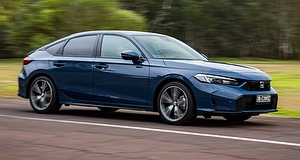28 April 2025

The EU’s new-car market continued its sluggish trend of registrations in 2025 during March. However, these results suggest an improvement may be around the corner. Autovista24 special content editor Phil Curry assesses the latest figures.
The EU’s new-car market suffered another decline in March, marking a first-quarter struggle in 2025. However, the month’s 0.2% dip in registrations only equated to 2,370 fewer units delivered across the 27 member states. When adding in the EFTA and UK regions, the European market grew by 2.8%.
The latest data from ACEA shows a total of 1,029,519 units were delivered to EU customers in March. This is down in what is typically a high-volume period.
Both France and Germany recorded drops in the month, of 14.5% and 3.9% respectively. It was left to fellow big four markets Spain and Italy to pick up the pace. They did so, with respective rises of 23.2% and 6.3%.
Results across the smaller-volume markets caused ripples that led to the almost static year-on-year result. The Netherlands, down 14.8%, and Belgium, down 10.2%, struggled. Yet, Czechia and Poland countered these losses, with growth of 19.3% and 6.3% respectively.
In the first three months of 2025, the EU market suffered a 1.9% decline, equating to 53,974 fewer units compared to the first quarter of 2024. A total of 2,715,008 passenger cars took to the bloc’s roads in the period.
New-car market’s fine balance
The result highlights how finely balanced the new-car market in the EU is. While electric vehicle (EV) and hybrid registrations continue to improve, the internal-combustion engine (ICE) market is struggling.
This may be a result of the EU’s CO2 emission regulations, which came into effect at the start of this year. Carmakers have a stricter target of average CO2 levels per kilometre across their fleets. For some, the best course of action has been to limit the number of petrol and diesel models available.
That decision has a knock-on effect. While electrified vehicle popularity is growing, and more carmakers are adding these powertrains to their fleets, it is not enough to make up for the reduction of ICE models.
Registrations of hybrids and EVs combined have seen strong double-digit growth in each month of the first quarter. However, this has not been enough to offset the declines in the ICE market.
Yet, things may start to change in the coming months. While the stricter rules still exist, the EU Commission has now allowed carmakers to spread their results over three years. This means one bad yearly result can be made up in the corresponding years.
It remains to be seen how this change will influence carmaker strategy. Will they provide more of the profitable ICE variants, or stay sustainable on the electrified path?
Petrol registrations plunged 20.7% in March, with 290,396 deliveries. This was the second month in succession that figures fell by more than a fifth. The result left the powertrain with a 28.2% market share. This hold is petrol’s lowest-ever market share, and a 7.3 percentage point (pp) drop on the same month last year.
Petrol’s decline was driven by a 44.2% fall in France, while Germany saw figures drop 29.4%. Only three countries saw petrol registrations improve, albeit on low volumes. Cyprus was up 38.7% to 706 units, while Czechia saw 12.1% more deliveries, with 10,710 units. Latvia had the biggest rise, of 33.2%, but with a volume of just 1,361 deliveries.
The overall figure means that in the first quarter, petrol registrations fell 20.6%, with a 28.7% market share. This was a drop of 6.8pp compared to the first three months of 2024.
Meanwhile, diesel registrations fell 25.5% in March, with 95,315 units. The fuel type’s 9.3% market share was down 3.1pp year on year. During the first quarter, diesel deliveries were down 27.1%. It recorded a 3.3pp drop in market share during this period to 9.5%.
The fall of both powertrain types meant that the ICE market fell 21.9% in March. This equates to a difference of 108,312 units from 12 months ago. The technology made up 37.5% of total registrations, down from its 47.9% share in March 2024, and falling further away from the electrified sector.
In the first quarter, ICE registrations were down 22.3%, with 298,434 fewer deliveries. Its 38.3% market share equated to a drop of 10pp year on year.
Hybrids lead EU new-car market
While petrol and diesel registrations fell, all other powertrains enjoyed success in March. The biggest improvement went to hybrids, consisting of full and mild-hybrid powertrains. This sector grew 23.9% year on year, with 370,121 registrations.
The technology’s 36% market share was 7pp higher than in March 2024. This meant that the hybrid market continued to pull away from petrol as the market leader.
This growth was driven by France, with a 41.6% rise in registrations. This almost made up for the country’s shortfall in the petrol market. Italy was up 23.8%, while Germany also saw an 11.7% rise in hybrid deliveries.
In the first quarter, hybrids were up 20.7% compared to the same period last year, with 964,108 deliveries. This gave it a 35.5% hold of total registrations, up from 28.9% recorded in 2024.
Meanwhile, plug-in hybrids (PHEVs) saw registrations improve by 12.4% in March, with an 8% market share. The 82,111-unit total was not enough to beat diesel, meaning the powertrain remained the least popular major technology in the EU.
The PHEV market was not helped by a 49.1% drop in France, although a 65.8% improvement in Germany offset this result.
In the first quarter, PHEV deliveries were up 1.1% with 207,048 units. March’s result was able to drag the technology out of a year-to-date decline from the first two months. This also helped to improve the market share by 0.2pp to 7.6%.
BEVs are best
The EU’s battery-electric vehicle (BEV) market saw a 17.1% improvement in March, reaching 157,505 deliveries. The all-electric technology took a 15.3% hold of overall registrations, an improvement of 2.3pp year on year.
While France saw BEV registrations decline 13.9%, other markets witnessed stronger results. Despite often having lower results than other markets, both Spain and Italy saw big gains in the month. Spanish BEV deliveries increased 93% to 8,101 units, while Italian figures rose 74.8%, to 9,369 deliveries.
The other high-volume BEV market of Belgium also saw gains, of 16.6%. However, the Netherlands suffered a 14.1% drop in deliveries.
BEVs offer carmakers the best route to reduce CO2 emissions, in line with their 2025 targets. However, with some countries having reduced their incentive schemes, the technology has faced some challenges in recent years. Yet, its performance in 2025 has been strong so far.
Across the first quarter, BEVs have enjoyed the biggest improvement out of all powertrains compared to the same period last year. Its 412,997-unit total is 23.9% higher than that achieved last year. The market share of 15.2% was up by 3.2pp year on year.
Shortfall remains
The EV market saw growth of 15.5% in March, improving volumes by 32,094 units. This performance gave a share of 23.3% in the month, up by 3.2pp compared to one year ago.
In the first quarter, the EV market increased deliveries by 15.2%, thanks to the strong results in the BEV market. This equated to an improvement of 81,868 units.
Adding hybrids to the EV sector, the electrified market grew 20.4% last month. The 103,379-registration improvement was just 4,933 units short of offsetting the ICE decline. In the first quarter, electrified models were up 18.5% compared to the same period last year. This equates to a 246,918-unit difference.





